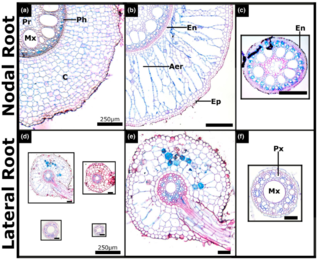Bioenergy sorghum’s deep roots: A key to sustainable biomass production on annual cropland
A. Lamb et al. "Bioenergy sorghum’s deep roots: A key to sustainable biomass production on annual cropland" GCB-Bioenergy 14 (2021) [DOI:10.1111/gcbb.12907]
Bioenergy sorghum has high biomass yield potential, drought resilience, good nitrogen use efficiency, and a root system that contributes to the accumulation of soil organic carbon. In this study, field grown bioenergy sorghum root systems were analyzed during the growing season to characterize their depth, biomass, morphology, anatomy, and gene expression profiles. Bioenergy sorghum roots grew continuously during a 155-day growing season producing ~175 nodal roots, accumulating ~7 Mg of dry biomass per hectare, and reaching >2 m deep in the soil profile. Nodal roots within 20 cm of the stem were 1–5 mm in diameter, whereas roots deeper in soil profiles were enriched in lateral roots with small diameters (~30–500 µm) enabling growth through soil macropores. In older field-grown plants, roots with intact endodermal, vascular and inner root tissues were surrounded by degraded or aerenchyma-filled epidermal and cortical cell layers. Transcriptome analysis of nodal, surface, and deep roots identified >2,500 differentially expressed genes involved in root growth, transport, adaptation, defense, and AMF–root interaction. Deep roots (180–240 cm) differentially expressed genes that regulate lateral root growth. Surface roots (0–20 cm) located mid-row differentially expressed genes involved in nitrate transport, whereas ammonium transport genes were expressed in surface and deep roots and genes involved in phosphate transport were expressed in nodal, surface, and deep roots. Overall, bioenergy sorghum's long growing season enables root systems to grow deeper and accumulate more biomass than annual grain crops such as maize, attributes that could help restore annual cropland soil organic carbon levels and improve soil productivity. Deep roots active in nutrient transport are positioned to take-up fertilizer leached deep into soil profiles mitigating potential nutrient run-off. Bioenergy sorghum's large and deep root system is a key to sustainable production of biofuels, biopower, and bioproducts on annual cropland.
Root morphometric data is available at Knowledge Network for Biocomplexity. Expression data are deposited on the Joint Genome Institutes Genome Portal.
